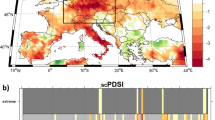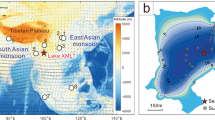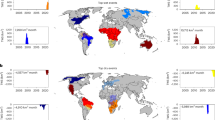Abstract
EXTREME large-scale droughts in North America, such as the 'Dust Bowl' of the 1930s, have been infrequent events within the documented history of the past few hundred years, yet this record may not be representative of long-term patterns of natural variation of drought intensity and frequency. In the Great Plains region of central North America, historical droughts have persisted longer than in any other part of the United States1, but no detailed records of drought patterns in this region have hitherto been obtained that extend beyond the past 500 years. Here we present a reconstruction of drought intensity and frequency over the past 2,300 years in the Northern Great Plains, based on lake salinity fluctuations inferred from fossil diatom assemblages. This record, of sub-decadal resolution, suggests that extreme droughts of greater intensity than that of the 1930s were more frequent before AD 1200. This high frequency of extreme droughts persisted for centuries, and was most pronounced during AD 200–370, AD 700–850 and AD 1000–1200. We suggest that before AD 1200, the atmospheric circulation anomalies that produce drought today were more frequent and persistent.
This is a preview of subscription content, access via your institution
Access options
Subscribe to this journal
Receive 51 print issues and online access
$199.00 per year
only $3.90 per issue
Buy this article
- Purchase on Springer Link
- Instant access to full article PDF
Prices may be subject to local taxes which are calculated during checkout
Similar content being viewed by others
References
Karl, T. J. Clim. Appl. Meteorol. 22, 1356–1366 (1983).
Bryson, R. Geogr. Bull. 8, 228–269 (1966).
Oladipo, E. J. Climatol. 5, 655–664 (1985).
Trenberth, K., Branstator, G. & Arkin, P. Science 242, 1640–1645 (1988).
Namias, J. J. Clim. Appl. Meteorol. 22, 30–39 (1983).
Chang, F. & Wallace, J. Mon. Weath. Rev. 115, 1253–1269 (1987).
Fritz, S. Limnol. Oceanogr. 35, 1771–1781 (1990).
Laird, K., Fritz, S., Grimm, E. & Mueller, P. Limnol. Oceanogr. 41(5), 890–902 (1996).
Cumming, B., Wilson, S., Hall, R. & Smol, J. Bibliotheca Diatomologica 31, 1–207 (1995).
Gasse, F., Juggins, S. & Khelifa, L. Paleogeogr. Palaeoclimatol. Palaeoecol. 117, 31–54 (1995).
Wilson, S., Cumming, B. & Smol. J. J. Paleolimnol. 12, 197–221 (1994).
Fritz, S., Juggins, S., Battarbee, R. & Engstrom, D. Nature 352, 706–708 (1991).
Fritz, S., Juggins, S. & Battarbee, R. Can. J. Fish. Aquat. Sci. 50, 1844–1856 (1993).
Line, J., ter Braak, C. & Birks, H. J. Paleolimnol. 10, 147–152 (1994).
Laird, K. thesis, Univ. Minnesota (1996).
Jacoby, G., Ivanciu, I. & Ulan, L. Paleogeogr. Palaeoclimatol. Palaeoecol. 64, 69–78 (1988).
Stockton, C. & Meko, D. J. Clim. Appl. Meteorol. 22, 17–29 (1983).
Hughes, M. & Brown, P. Clim. Dynam. 6, 161–167 (1992).
Stine, S. Nature 369, 546–549 (1994).
Graumlich, L. Quat. Res. 39, 249–255 (1993).
Lamb, H. Climate: Present, Past, and Future Vol. 2, Climatic History and the Future (Methuen, London, 1977).
Hughes, M. & Diaz, H. Clim. Change 26, 109–142 (1994).
Porter, S. Quat. Res. 26, 27–48 (1986).
Jirikowic, J. & Damon, P. Clim. Change 26, 309–316 (1994).
Bradley, R. & Jones, P. (eds) Climate Since A.D. 1500 (Routledge, London, 1992).
Clark, J. Nature 334, 233–235 (1988).
Currie, R. J. Geophys. Res. 89, 1295–1308 (1984).
Case, R. & MacDonald, G. Quat. Res. 44, 267–275 (1995).
Hansen, J. et al., in Greenhouse-Gas-lnduced Climatic Change: A Critical Appraisal of Simulations and Observations (ed. Schlesinger, M.) 211–229 (Eisevier Science, Amsterdam, 1991).
Tsonis, A. Nature 382, 700–702 (1996).
Stuiver, M. & Reimer, P. Radiocarbon 35, 215–230 (1993).
Thompson, D. IEEE Proc. Natl Aerosp. Electron. Conf. 70, 1055–1096 (1982).
Mann, M. & Lees, J. Clim. Change 33, 409–445 (1996).
Author information
Authors and Affiliations
Rights and permissions
About this article
Cite this article
Laird, K., Fritz, S., Maasch, K. et al. Greater drought intensity and frequency before AD 1200 in the Northern Great Plains, USA. Nature 384, 552–554 (1996). https://doi.org/10.1038/384552a0
Received:
Accepted:
Issue Date:
DOI: https://doi.org/10.1038/384552a0
This article is cited by
-
Multi-year climate variability in the Southwestern United States within a context of a dynamically downscaled twentieth century reanalysis
Climate Dynamics (2017)
-
Investigating potential effects of zooplankton grazing on diatom-inferred drought reconstructions
Hydrobiologia (2017)
-
Long-term precipitation-driven salinity change in a saline, peat-forming wetland in the Athabasca Oil Sands Region, Canada: a diatom-based paleolimnological study
Journal of Paleolimnology (2017)
-
A Moisture Balance Reconstruction for the Drainage Basin of Albemarle Sound, North Carolina
Estuaries and Coasts (2013)
-
Drought changes and the mechanism analysis for the North American Prairie
Journal of Arid Land (2013)
Comments
By submitting a comment you agree to abide by our Terms and Community Guidelines. If you find something abusive or that does not comply with our terms or guidelines please flag it as inappropriate.



